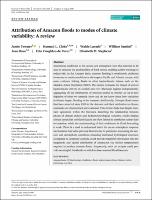Mostrar el registro sencillo del ítem
Attribution of Amazon floods to modes of climate variability: A review
| dc.contributor.author | Towner, Jamie | |
| dc.contributor.author | Cloke, Hannah L. | |
| dc.contributor.author | Santini, W. | |
| dc.contributor.author | Bazo, Juan | |
| dc.contributor.author | Coughlan de Perez, Erin | |
| dc.contributor.author | Stephens, Elisabeth M. | |
| dc.date.accessioned | 2020-12-30T20:06:20Z | |
| dc.date.available | 2020-12-30T20:06:20Z | |
| dc.date.issued | 2020-08 | |
| dc.identifier.uri | https://hdl.handle.net/20.500.12542/653 | |
| dc.description.abstract | Anomalous conditions in the oceans and atmosphere have the potential to beused to enhance the predictability of flood events, enabling earlier warnings toreduce risk. In the Amazon basin, extreme flooding is consistently attributedto warmer or cooler conditions in the tropical Pacific and Atlantic oceans, withsome evidence linking floods to other hydroclimatic drivers such as theMadden–Julian Oscillation (MJO). This review evaluates the impact of severalhydroclimatic drivers on rainfall and river discharge regimes independently,aggregating all the information of previous studies to provide an up-to-datedepiction of what we currently know and do not know about how variationsin climate impact flooding in the Amazon. Additionally, 34 major flood eventsthat have occurred since 1950 in the Amazon and their attribution to climateanomalies are documented and evaluated. This review finds that despite com-mon agreement within the literature describing the relationship betweenphases of climate indices and hydrometeorological variables, results linkingclimate anomalies and flood hazard are often limited to correlation rather thanto causation, while the understanding of their usefulness for flood forecastingis weak. There is a need to understand better the ocean–atmosphere responsemechanisms that led to previous flood events. In particular, examining the oce-anic and atmospheric conditions preceding individual hydrological extremes,as opposed to composite analysis, could provide insightful information into themagnitude and spatial distribution of anomalous sea surface temperaturesrequired to produce extreme floods. Importantly, such an analysis could pro-vide meaningful thresholds on which to base seasonal flood forecasts | es_PE |
| dc.format | application/pdf | |
| dc.language.iso | eng | |
| dc.publisher | John Wiley & Sons | |
| dc.relation.ispartof | urn:issn:1469-8080 | |
| dc.rights | info:eu-repo/semantics/openAccess | es_PE |
| dc.rights | Atribución-NoComercial-SinDerivadas 3.0 Estados Unidos de América | * |
| dc.rights.uri | http://creativecommons.org/licenses/by-nc-nd/3.0/us/ | * |
| dc.source | Repositorio Institucional - SENAMHI | es_PE |
| dc.source | Servicio Nacional de Meteorología e Hidrología del Perú | es_PE |
| dc.subject | Hydroclimatic Drivers | es_PE |
| dc.subject | Inundaciones | es_PE |
| dc.subject | Pronóstico de Inundación | es_PE |
| dc.subject | Cuencas | es_PE |
| dc.subject | Amazonia | es_PE |
| dc.subject | Modelos | es_PE |
| dc.subject | Hidrología | es_PE |
| dc.title | Attribution of Amazon floods to modes of climate variability: A review | en_US |
| dc.type | info:eu-repo/semantics/article | en_US |
| dc.identifier.isni | 0000 0001 0746 0446 | |
| dc.description.peerreview | Por pares | |
| dc.identifier.doi | https://doi.org/10.1002/met.1949 | |
| dc.identifier.journal | Meteorological Applications | |
| dc.subject.ocde | https://purl.org/pe-repo/ocde/ford#1.05.11 | |
| dc.subject.sinia | inundaciones - Clima y Eventos Naturales | |
| dc.type.sinia | text/publicacion cientifica | |
| dc.identifier.url | https://hdl.handle.net/20.500.12542/653 |
Ficheros en el ítem
Este ítem aparece en la(s) siguiente(s) colección(es)
-
Artículo científico [171]









